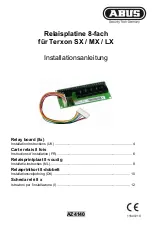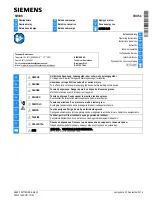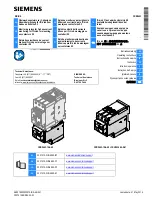
2
Circuito di comando
I contattori sono equipaggiati con un alimentatore (situato nella parte superio-
re dell'apparecchio) che permette di alimentare la bobina indifferentemente
sia in corrente alternata a 50 o 60Hz che in corrente continua. La tensione di
comando è indicata sulle bobine e sull'alimentatore.
I contattori offrono inoltre la possibilità di variare il tempo di rilascio in: normale
(150-200ms) oppure ritardato (0,5-1s).
Il rilascio normale ha le stesse caratteristiche di funzionamento dei contattori
normalmente in commercio.
Il rilascio ritardato ha le seguenti caratteristiche di funzionamento:
a)
Il contattore predisposto sul rilascio ritardato, se attratto, non rilascia
per brevi mancanze della tensione di alimentazione della bobina.
Queste mancanze sono anche comunemente dette "buchi di tensio-
ne" e possono verificarsi spesso su talune reti ed impianti.
b)
Il contattore diventa insensibile ai pompaggi ed alle incertezze di
contatto di dispositivi automatici di comando come pressostati,
termostati o altri dispositivi di regolazione equivalenti.
Il rilascio ritardato, però, può non essere compatibile con schemi e sequenze
circuitali ove non è previsto il funzionamento del contattore con rilascio
ritardato.
Occorre quindi valutare le conseguenze circuitali del rilascio ritardato prima
del suo impiego.
I contattori sono normalmente forniti predisposti con rilascio normale.
La variazione del tempo di rilascio è effettuabile a cura dell'utilizzatore
mediante un semplice spostamento di connessioni ad innesto situati all'inter-
no del gruppo alimentatore (vedi "Schema elettrico" nella pagina seguente).
Qualora non si intenda rinunciare ai vantaggi del rilascio ritardato anche
quando il comando del contattore è eseguito con pulsanti di marcia e arresto
per cui per arrestare il motore occorrerebbe tenere premuto il pulsante
d'arresto per 1 secondo, occorre collegare il pulsante di arresto sui morsetti
M1 e M2 eseguendo le seguenti operazioni:
1.
Togliere il parafiamme e rimuovere il ponticello tra i terminali M1 e
M2.
2.
Collegare a M1 e M2 il pulsante di arresto e rimontare il parafiamme;
per un elevato numero di manovre ora si deve proteggere il pulsante
di arresto con un condensatore come indicato in tabella.
Il suddetto sistema di comando può comunque essere utlilizzato quando sia
richiesto un rilascio molto rapido del contattore (circa 20 ms).
PM : Pulsante marcia . . . . . . . . . . . . . . . . . . . . . .
Start push-button
PA : Pulsante arresto . . . . . . . . . . . . . . . . . . . . .
Stop push-button
C2 : Contatto di autoalimentazione . . . . . . . . . . .
Self feeding contact
O/L : Contatto NC del dispositivo di protezione . .
Protection device NC contact
I
: Interruttore . . . . . . . . . . . . . . . . . . . . . . . . . .
Switch
A
: Automatismo . . . . . . . . . . . . . . . . . . . . . . . .
Automatic device
Ca : Condensatore di protezione . . . . . . . . . . . .
Protection capacitor
Alimentazione
Supply
Alimentazione
Supply
Comandi a interruttore
Switch controls
Control circuit
Contactors are equipped with a feeder group (located in the upper part of the
devices) that permits to have the coil a.c. (50 or 60Hz) or d.c. powered. The
control voltage is indicated on the coils and on feeder group.
Furthermore, contactors offer the possibility to change the dropout time as
follows: normal (150-200ms) or delayed (0,5-1s).
Normal dropout offers the same operating characteristics as those of contac-
tors normally present on the market.
The delayed dropout has the following operating characteristics:
a)
In sealed condition the contactor, that has been preset for delayed
dropout, does not open if short-lasting supply control voltage failures
occur.
These failures, that are also commonly called "voltage holes" are
frequently present on certain networks and installations.
b)
The contactor becomes insensitive to pumping and uncertain opera-
tions of automatic control devices (for example: a pressure switch, a
thermostat or an equivalent automatic device).
Delayed dropout may, however, not be compatible with diagrams and circuital
sequences where no provision has been made for contactor featuring delayed
dropout. Therefore, the estimation of the circuital sequences of the delayed
dropout is highly recommended before deciding to use this feature.
Delivery status of contactors is with normal dropout. The users can perform
the variation of the dropout time: this is possible by simply displacing some
fast-on connections located inside the feeder group assembly (see "Electrical
diagram" on the following page).
If the user does not intend to give up the advantages deriving from the delayed
dropout even when the contactor is operated through start stop push buttons
(in this case to stop the motor the push button must be kept pressed for over
1s), the push button must be connected to terminals M1 and M2; the following
operations should be performed:
1.
Remove the arc-chute.
2.
Remove the jumper between terminals M1 and M2.
3.
Connect the stop push button to terminals M1 and M2, then assemble
the arc-chute again. Please note that if a high number of operations
are required, the stop push button must be protected by means of a
capacitor (see table).
This control system can be utilized when a very quick dropout of contactor
(20ms about) is required.
Comandi a pulsante
Push-button controls
Alimentazione
Supply
Alimentazione
Supply
Ca
Ca
D6-02
T5-04
T6-03
Tempi di funzionamento con comando dai terminali A1-A2
Operating time controlling at A1-A2 terminals
Predisposto con:
Rilascio normale
Rilascio ritardato
Arranged with:
Normal dropout
delayed dropout
Tempo di chiusura
50 ... 100 ms
Closing time
Tempo di rilascio
150 ... 200 ms
0,5 ... 1 s
dropout time
T6-02
Tempi di funzionamento con comando dai terminali A1-A2 e M1-M2
Operating time controlling at A1-A2 and M1-M2 terminals
Predisposto con:
Rilascio normale
Rilascio ritardato
Arranged with:
Normal dropout
delayed dropout
Tempo di chiusura
50 ... 100 ms
Closing time
Tempo di rilascio disalimentando
dai terminali A1-A2
150 ... 200 ms
0,5 ... 1 s
Dropout time removing voltage
at A1-A2 terminals
Tempo di rilascio interrompendo
dai terminali M1-M2
circa 20 ms about
Dropout time breaking the circuit
at M1-M2 terminals
" Ca "
Condensatore
Capacitor
Tensione di comando
<100V
100-250V
340-480V
Control voltage
Non necessario
0,22 µF
0,1 µF
Unnecessary
480VAC/1200VDC
960VAC/2400VDC
Summary of Contents for GH55
Page 8: ...8 www ghisalba com...


























